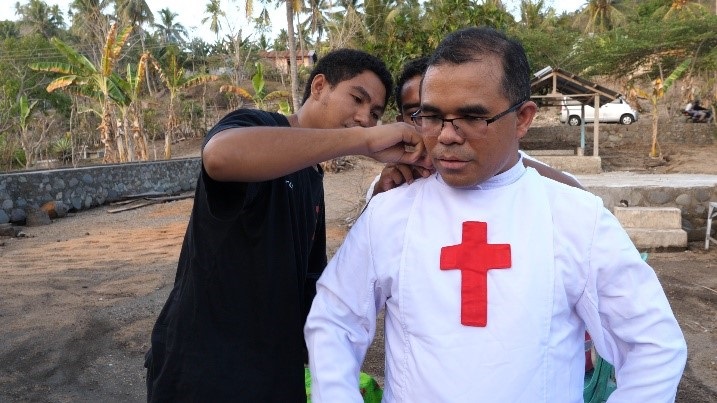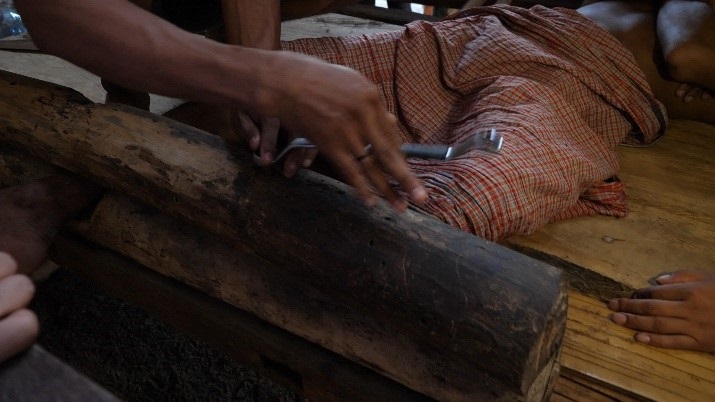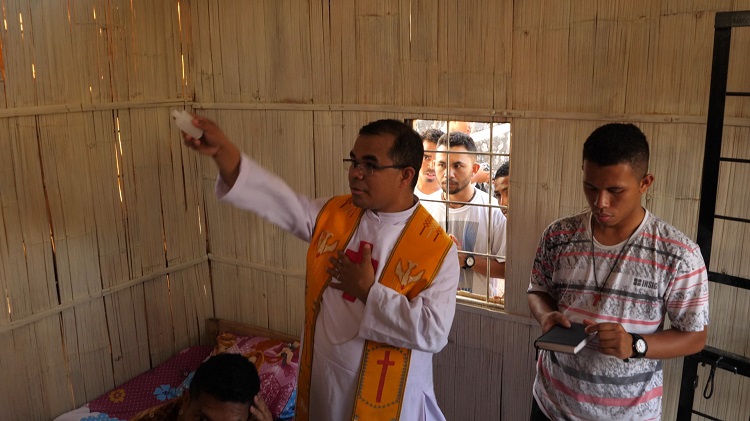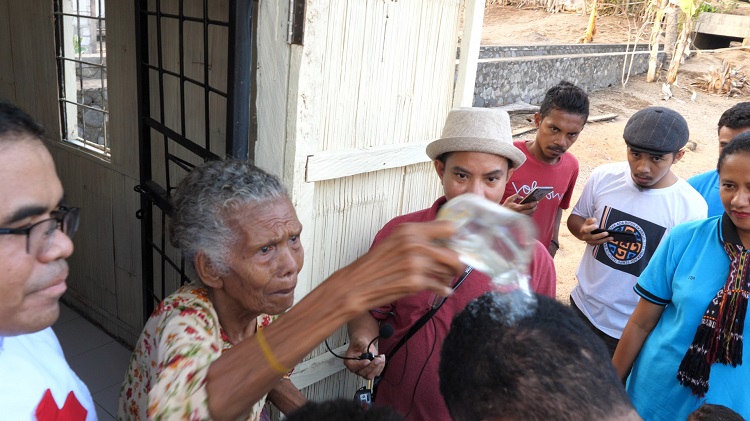Versi Bh. Indonesia
Camillian priests are setting the example for social workers when it comes to releasing patients from pasung in Flores
Ade W Prastyani, Diana Setiyawati & Erminia Colucci
On a late afternoon in early December, we joined Camillian priests Pater Andi and Pater Alfons and more than a dozen of their students (fraters) to travel to Lela sub-district, an hour’s drive from Nita, the capital of Sikka district, on Flores island. Upon our arrival, both paters quickly walked from the road to a house at the sea. Two nurses from the local puskesmas (community health centre) had been waiting for us. They had prepared the community for the theatrical event – an unusual collaboration between health care workers and priests – that was about to start.
After Pater Andi changed into a white robe with a bright red cross, the symbol of the Camillian Order, he briskly walked towards a bamboo hut at the back of the house. In this hut, a patient was confined. The patient was in his early twenties and was naked except for a sarong which covered the lower half of his body. His left leg was restrained in a hole between two pieces of timber, which effectively precluded him from moving. He was in pasung (shackles). Fortunately, he had been confined to the bamboo hut for less than a year. His family knew he had been unwell since he was 13 years old, suffering from schizophrenia. At the time of the visit, the patient’s parents had passed away and he was living with his older sister and her husband, their two small children, and his grandmother.
Many Indonesian families put mentally ill relatives in pasung because they are terrified of their violent outbursts. At times they do so at the urging of neighbours who perceive them as threats to the community’s safety, although some families restrain their mentally ill relatives for their own protection. Often, family members have suffered years of trauma and are at their wits end. Very few have access to formal mental health care services and medications. Many are not aware that their relative has a mental illness.
Sikka district has 688 people living with mental illness, according to the acting head of the Sikka District Health Office. Data from the 2018 Indonesian Ministry of Health’s Basic Health Research Survey (Riskesdas 2018) indicates that 14 per cent of patients diagnosed with severe mental illness have experienced pasung; in rural areas it is 17.7 per cent, in urban areas 10.7 per cent. This young man’s predicament is unfortunately not uncommon. In Lela sub-district, he was the fifth patient either in pasung or post-pasung in the care of the puskesmas and the Camillian priests.

About two dozen people were standing around the small bamboo hut when the priests arrived: close family, neighbours and other relatives. They all witnessed the Camillian fraters removing the timber beams and freeing the young man’s leg. Because he had not been in pasung for very long, his muscles had not yet atrophied, as often happens to such persons. He was still able to stand up but could only move around slowly. The fraters picked him up and carried him towards a small house close by. Some in the crowd cheered.
The house, built especially for this patient, is called a rumah aman (safe house). It was only three by four metres but looked clean and sturdy. Because of the painted bamboo walls covering both inside and out, and the tin roof, the house looked no different to the others in the village. It even had the advantage of tiled flooring as distinct from the dirt floors in most other houses. However, its external appearance was deceptive, and its entire structure, including its door, was underpinned by concealed metal rods. ‘The person should not see the house when it is being built, before the bamboo walls are put up, because they might think that it is a prison for them,’ remarked Pater Alfons during one of our conversations. Apparently, that had happened a few months earlier. When a patient who was still in chains observed the safe house under construction, he refused to move there.
A theatrical release
Witnessed by relatives and neighbours, the patient stood in front of his new abode, where his grandmother waited for him holding a leaf and a glass of water. Next to her were Pater Andi and Pater Alfons while the fraters stood next to the young man. When the patient approached, his grandmother recited a mantra: ‘blatan ganu wair, blirang ganu bao’ (cold like the water, cool like the banyan tree). This mantra is derived from a cooling ceremony traditional to Maumere culture, which is performed for the sick, for returning migrant workers, or to welcome government officials. Its function is to ward off evil spirits. Not only did the older woman sprinkle water on her grandson using the leaf, but she also poured the glass of water over his head. ‘Mai tama seleboang’ (Let’s go inside), she said.
Once inside, the patient sat on his new bed. He glanced at us, probably wondering who we were. The fraters immediately dressed him in a new shirt while Pater Andi started a blessing ceremony. As he was reading from the Camillian prayer book, he was briefly cut off by the young man’s laughter. Pater Andi gestured him to be quiet and the whole crowd began to recite the Confiteor (I Confess) prayer in unison. Disengaged and distractible, the patient scratched his head and waved to his family standing outside.
After the prayer, Pater Andi took a small bottle filled with holy water and sprinkled it in all directions, before going outside to sprinkle the rest of the house. The young patient’s relatives and neighbours watched attentively as Pater Andi paced back and forth. Returning inside, Pater Andi blessed the young man with the holy water. Then, with his hands on the patient’s head, Pater Andi prayed for his healing, his voice gentle but clear. Nobody made a sound. After the prayers, Pater Andi sat next to the young man. The puskesmas staff stood close by and invited the young man’s grandmother, sister and cousin to come into the house and sit on the bed. The sister, who held her youngest child, was close to tears, as was the grandmother. Pater Andi thanked them for all their efforts in taking care of the young man over all these years. The family started crying. The puskesmas staff smiled compassionately.
Expansion of roles
The Camillian Order, which is part of the Roman Catholic Church, commissioned the rumah aman. The fraters helped in its construction. Building each rumah aman costs around Rp.20 million (about A$2000). Some of these funds were donated and some came from the order’s own funds. The aim is straightforward: when persons with mental illness live separately but nearby while receiving medication, the family, relatives, and neighbours can witness their recovery first hand. The family can decide when to open the door and for how long, thereby allowing patients to move around freely.

This program started in 2015, when Father Luigi, an Italian priest of the Camillian Order, found out that close to the order’s monastery and seminary school in Nita sub-district, Sikka regency, a man had been in pasung for well over a decade. He and two Indonesian Camillian priests designed the rumah aman as a safe way of moving patients out of strict confinement while staying in their family environment. The Camillian Order has thus far built at least 14 safe houses, most of them in Sikka regency, and have released almost 30 people from pasung. They find persons in pasung through word of mouth or with the assistance of local puskesmas staff.
Building a rumah aman is never straightforward. At times, Pater Alfons and Pater Andi spend months trying to persuade patients and their families that these ‘safe houses’ are truly safe. Persons suffering from schizophrenia can be violent and destructive, which was why family members put their loved ones in pasung. The Paters’ involvement and the theatrical ritual to release patients from pasung have been important, and potent, in local communities. This ritual publicly absolves all key actors, including patients and their families, from past mistakes. When we witnessed the patient’s sister crying, when Pater Andi sat with her next to her brother, we realised that, finally, she was able to release her emotions. Her family no longer had to face this situation on their own.
The Camillian Order’s priests go beyond the call of duty for people they are helping: ‘We decided that we give everything we can. We work also to [provide patients with] a national ID card and a social [health] insurance card to rely on when they get sick again.… Most of our patients, when they get sick, they cannot pay, because most of them are not registered,’ Pater Andi explained passionately. The social health insurance he mentioned is Indonesia’s Jaminan Kesehatan Nasional or JKN (National Health Insurance) program, colloquially known as BPJS-Kesehatan. This program provides health insurance to all Indonesians who sign up.
JKN covers mental health care, which should first be provided at the primary care level, in the puskesmas. However, supplies of psychiatric medications are not always available there. Fortunately, the Camillian priests often source these medications for the patients in their care. They have built partnerships with local specialists, initially with a senior neurologist and, two years ago, with a psychiatrist who had just started working in Sikka, and with several puskesmas physicians to guarantee the supply of medication. After physicians prescribe them, the Camillian priests buy medications in local private pharmacies on the patient’s behalf. The priests also provide patient’s families with livelihood support by giving them goats and chickens. This not only improves the family’s finances, but also their morale. A favourable family dynamic after pasung release is vital to the recovery of people they are helping.

Lessons learned
There are two lessons that can be drawn from the Camillian priests’ mission and the rituals they perform. First, medication alone is not enough to assist patients being released from pasung and their families. Civic and religious groups can provide various forms of assistance, and mental health care professionals should be thoroughly aware of the social situation, culture and spiritual beliefs of their patients and their caregivers. They should be familiar with the various informal actors that are important for their patients and their families. The puskesmas staff, the Camillian priests, and the family in the example above agreed on the roles each could play for the young man in their care.
Indonesia’s welfare and health care system doesn’t yet consistently provide the various forms of support the Camillian priests offer. Social workers can, however, provide periodic assessment and coordination of care and assistance for mentally ill patients and their families. When they are familiar with the situation of persons with mental illness and their caregivers, they could provide targeted support, assisting the recovery of the individuals in their charge. Social workers remain a relatively rare resource in Indonesia, and many require more training in managing persons with severe mental illness. They are as important as health professionals in ensuring the recovery of the mentally ill. They could participate in advocacy and planning, both at the national and at the city/regency level, and assist with budgeting of financial assistance for persons with mental illnesses.
Ade W Prastyani (ade.prastyani@gmail.com) is a researcher for the Centre for Public Mental Health at the Faculty of Psychology at Gadjah Mada University under the funding from this research project. Diana Setiyawati (diana@ugm.ac.id) is the director of the Centre for Public Mental Health at Gadjah Mada University. Erminia Colucci (E.Colucci@mdx.ac.uk) is an associate professor in Visual and Cultural Psychology at Middlesex University London.
The observations reported in this article have been recorded as part of the research project ‘Using collaborative visual research methods to understand experiences of mental illness, coercion and restraint in Ghana and Indonesia’, an Economic and Social Research Council (UK) GCRF-funded project. More information here. The film-stills and field observations featured in this article were taken by the authors as part of their fieldwork.
